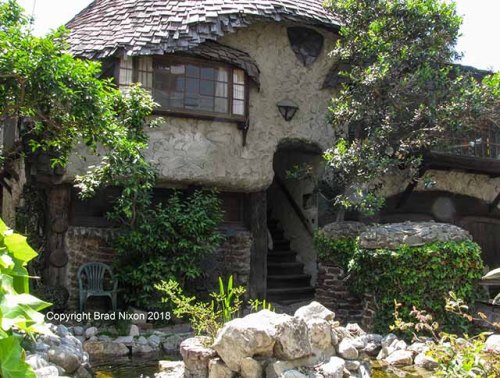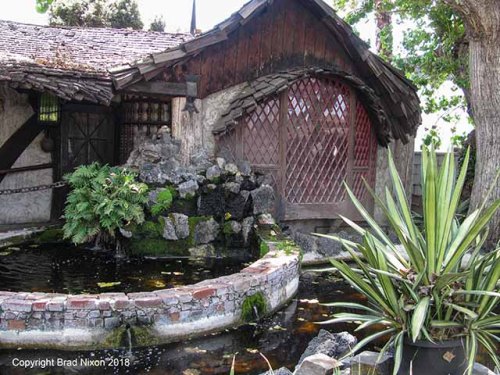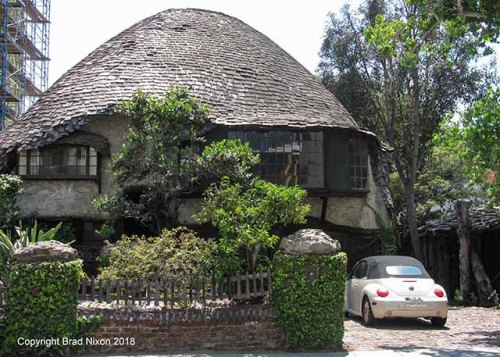You may think of my town — Los Angeles — as a bit quirky. We’re often mentioned as one of the western world’s hubs of odd behavior and lifestyles. We have some idiosyncratic architecture, too. Although I write a lot about L.A. architecture, I feel I’ve not been thorough, because the vast majority of my reports about the structures of La La Land have focused on interesting but far-too-staid examples of the craft: post offices, government buildings, museums, libraries and such. Every city has those.

Let us go, then, you and I, to Culver City, home of about 40,000 people, ten miles west-southwest of downtown L.A. Founded in 1917, it became a center of the region’s film industry early on, and is still the home of Sony Pictures Entertainment, among others. For your audition to be on “Jeopardy!” you’ll go to Culver City.
Culver City’s a busy place, gentrifying, somewhat groovy if not entirely hip, and the original downtown is being heavily rebuilt, full of shops, restaurants and a few theaters. The older town is still in evidence, but a large number of the original structures from the 1920s and later have given way to new development during my 25 years in L.A., and the trend continues.
It’s somewhat of a surprise, then, to cruise along narrow Dunn Drive, wedged between heavily traveled Venice and Washington Boulevards. Dunn is lined on both sides with four-story condominium buildings, but you’ll encounter not just an original set of bungalows from the 1920s, but remarkable ones.

Officially, those erstwhile elf cottages are known as Garden Court. The style also has an official name: “Storybook architecture.” Drive around L.A. for a while and you’ll encounter more than a few examples of the genre, but Garden Court could stand for all.

There are three buildings at Garden Court, which may have been built as early as 1917 (my sources disagree). In about 1946, an engineer named Lawrence Joseph started remodeling and didn’t stop until 1970.

Mr. Joseph — a sailor as well as engineer and carpenter — reportedly added unique details inside as well, carrying out a nautical theme with plank wood and hardware crafted from boat latches. And then there’s the landscaping:

The pond is home to goldfish and an uncountable number of turtles, which were enjoying the sunny California day in their retreat amidst the metropolis.

It almost goes without saying that the compound is commonly referred to as the “Hobbit Houses.”

Nor will it surprise you to learn that Mr. Joseph worked for a time at Disney, prior to serious, big-time aerospace engineering at the legendary Skunk Works.
I don’t think you need much more commentary from me; the place speaks for itself. I regret, for once, that I visited on a brilliantly sunny day, because the harsh backlighting makes it difficult to pick out details of the deeply shaded dark wood exteriors.

I will add that wood shingle roofs aren’t unknown in Los Angeles, and in some portions of the metropolis were the preferred style in days before building codes restricted their use due to the ever-present risk of fire. My own house, built in 1955, originally had a wood shake roof. But few structures boast a roof as enticingly bizarre as Garden Court’s.

Garden Court is an official Los Angeles Historic-Cultural Monument, and has received some protection from the admirable Los Angeles Conservancy. One hopes that with those measures in place, it’ll be there for some time to come.
Visiting Garden Court
Garden Court is at 3819 Dunn Drive, Los Angeles, California.
Bear in mind that these are private residences. One assumes the residents are accustomed to having their homes gawked at and photographed, but beyond the brick wall it’s private property. I’m grateful that the site has been left open to a view from the sidewalk, rather than ensconced behind fencing or hedges, which would tempt the visitor to step across the line just to get a look.
There is a small amount of one hour free street parking on Dunn Street. You might get lucky, but you may need to park along Washington or Venice Blvds., an adjacent side street, or, failing that, in a city parking garage on Watseka St., three blocks northwest.
Take advantage of your visit to walk around Culver City, too. There are some excellent restaurants, often lively with workers breaking for lunch from Sony and a number of smaller studios and creative enterprises that thrive in the area, or the evening pre-theater crowd.
Perhaps L.A.’s most famous storybook house is “The Witch’s House” in Beverly Hills, often included if you take one of those “Homes of the Stars” tours. Click here to read about it.
© Brad Nixon 2018. I’m grateful for information provided by An Architectural Guidebook to Los Angeles, David Gebhard and Robert Winter, Gibbs Smith, 2003, and the Los Angeles Conservancy website, retrieved June 7, 2018.
Hobbit Houses indeed! Just as an aside, I noticed very small cars…
LikeLiked by 1 person
By: feistyfroggy on June 8, 2018
at 12:46 pm
Indeed!
LikeLiked by 1 person
By: Brad Nixon on June 8, 2018
at 1:07 pm
Remarkable! I used to live in L.A., and never knew! Keep on travelin’.
LikeLiked by 1 person
By: La Boheme on June 8, 2018
at 6:56 pm
What you get for being a Westside guy.
LikeLike
By: Brad Nixon on June 8, 2018
at 7:20 pm
You’ve done a lot of reading, writing, and photographing of L.A. You should write a book “The Unknown L.A.”
LikeLike
By: LaBoheme on June 8, 2018
at 9:55 pm
But … if I tell everyone, it’ll be KNOWN!
LikeLike
By: Brad Nixon on June 8, 2018
at 10:37 pm
That’s ok. Fame is fleeting. — Gaius Crispus.
LikeLike
By: LaBoheme on June 9, 2018
at 6:58 pm
It’s odd to see these snuggled up against those more modern buildings; I assume that’s some renovation going on around them. I presume the landscaping helps to screen out some of the less attractive views for the residents. I hope so.
LikeLike
By: shoreacres on June 11, 2018
at 3:17 am
Brand new condo unit being built within about 10 feet of the left-hand residence. The story all over Culver City, like every town. The natural order of things. Can’t save everything, nor should we. Nor can every new structure be an icon of design, although one could wish that fewer of them would be flat-out plug ugly.
LikeLike
By: Brad Nixon on June 11, 2018
at 10:22 am